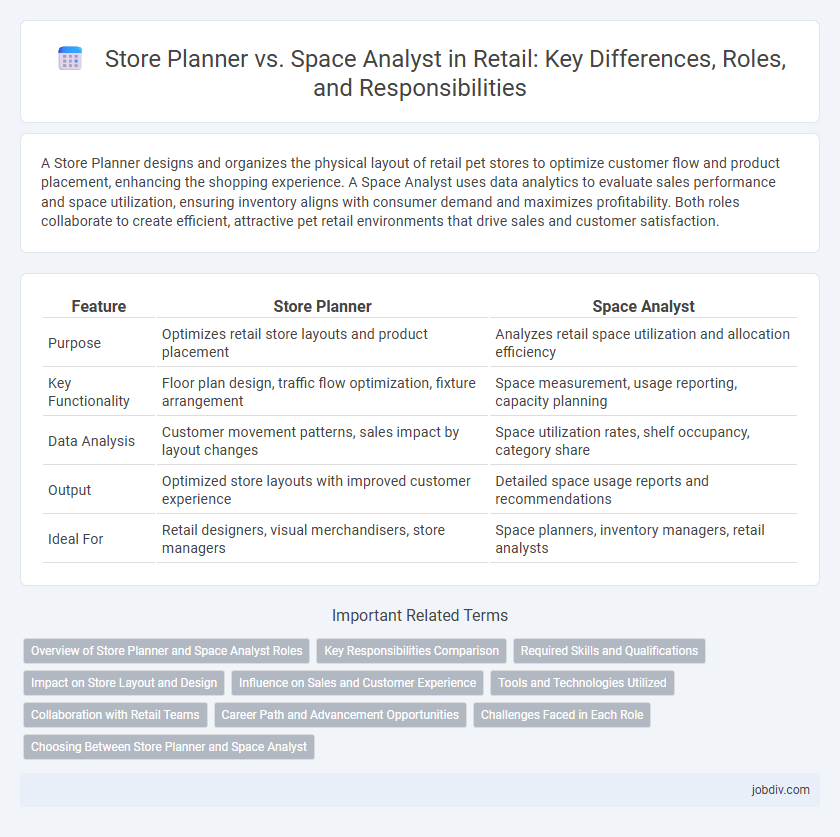A Store Planner designs and organizes the physical layout of retail pet stores to optimize customer flow and product placement, enhancing the shopping experience. A Space Analyst uses data analytics to evaluate sales performance and space utilization, ensuring inventory aligns with consumer demand and maximizes profitability. Both roles collaborate to create efficient, attractive pet retail environments that drive sales and customer satisfaction.
Table of Comparison
| Feature | Store Planner | Space Analyst |
|---|---|---|
| Purpose | Optimizes retail store layouts and product placement | Analyzes retail space utilization and allocation efficiency |
| Key Functionality | Floor plan design, traffic flow optimization, fixture arrangement | Space measurement, usage reporting, capacity planning |
| Data Analysis | Customer movement patterns, sales impact by layout changes | Space utilization rates, shelf occupancy, category share |
| Output | Optimized store layouts with improved customer experience | Detailed space usage reports and recommendations |
| Ideal For | Retail designers, visual merchandisers, store managers | Space planners, inventory managers, retail analysts |
Overview of Store Planner and Space Analyst Roles
Store Planners design retail layouts to optimize customer flow and enhance product visibility, focusing on visual merchandising and store aesthetics. Space Analysts analyze sales data and spatial efficiency to maximize store profitability by recommending product placements and inventory distribution. Both roles collaborate to create a seamless shopping experience that drives sales and operational efficiency.
Key Responsibilities Comparison
Store Planners design and optimize retail store layouts, focusing on customer flow, visual merchandising, and fixture placement to enhance the shopping experience. Space Analysts analyze store space utilization using data-driven insights to maximize sales per square foot and improve inventory placement efficiency. Both roles collaborate to balance aesthetic appeal with operational efficiency in retail environments.
Required Skills and Qualifications
Store Planners require strong skills in project management, architectural design, and knowledge of retail merchandising to create efficient and appealing store layouts. Space Analysts focus on data analysis, proficiency in retail analytics software, and understanding of space optimization to maximize sales per square foot. Both roles demand expertise in CAD tools, retail trends, and effective communication to align store design with business objectives.
Impact on Store Layout and Design
Store Planners focus on overall retail space utilization by creating efficient store layouts that enhance customer flow and product visibility, directly impacting sales and shopping experience. Space Analysts provide data-driven insights through space optimization models, measuring product performance within allocated areas to maximize revenue per square foot. Both roles collaborate to ensure store design aligns with merchandising strategies, improving operational efficiency and profitability.
Influence on Sales and Customer Experience
Store Planners optimize store layouts and product placements to enhance visual appeal and customer flow, directly increasing sales by encouraging more purchases. Space Analysts leverage data analytics to evaluate and adjust space utilization for maximum efficiency, improving customer experience through reduced congestion and easier navigation. Both roles collaborate to drive revenue growth by aligning physical environments with consumer behavior insights.
Tools and Technologies Utilized
Store Planners leverage CAD software, 3D modeling tools, and virtual reality applications to design and optimize store layouts, enabling immersive visualizations and efficient space planning. Space Analysts utilize advanced data analytics platforms, geographic information systems (GIS), and space utilization software to evaluate store performance, customer flow, and inventory placement. Both roles incorporate AI-driven optimization tools and real-time data integration to enhance decision-making in retail space management.
Collaboration with Retail Teams
Store Planners collaborate closely with retail teams to design efficient store layouts that enhance customer flow and maximize product visibility. Space Analysts work alongside merchandising and operations teams to optimize inventory placement and store space utilization using data-driven insights. Both roles rely on seamless communication to align strategic goals with on-the-ground retail execution.
Career Path and Advancement Opportunities
Store Planners focus on designing and optimizing store layouts to enhance customer experience and sales, often progressing into senior retail management or commercial design roles. Space Analysts specialize in data-driven space utilization and inventory management, with career advancement leading towards retail analytics, operations management, or supply chain strategy positions. Both paths offer growth opportunities, with Store Planners leaning toward creative leadership and Space Analysts toward analytical and strategic roles in retail.
Challenges Faced in Each Role
Store planners face challenges in optimizing store layouts to balance customer flow, product placement, and brand experience while adhering to budget constraints and tight deadlines. Space analysts struggle with accurately analyzing space utilization data, forecasting demand fluctuations, and integrating advanced analytics tools to improve inventory management and operational efficiency. Both roles require navigating complex retail environments but demand distinct skill sets focused on spatial design versus data-driven space optimization.
Choosing Between Store Planner and Space Analyst
Choosing between a Store Planner and a Space Analyst depends on the specific retail goals; Store Planners specialize in designing store layouts to enhance customer flow and visual merchandising, while Space Analysts focus on data-driven optimization of product placement and inventory allocation. Store Planners use spatial design principles and CAD tools to create engaging environments, whereas Space Analysts leverage sales data and analytics software to maximize sales per square foot. Retailers prioritizing customer experience and aesthetic appeal may opt for Store Planners, while those aiming to improve operational efficiency and product performance might favor Space Analysts.
Store Planner vs Space Analyst Infographic

 jobdiv.com
jobdiv.com